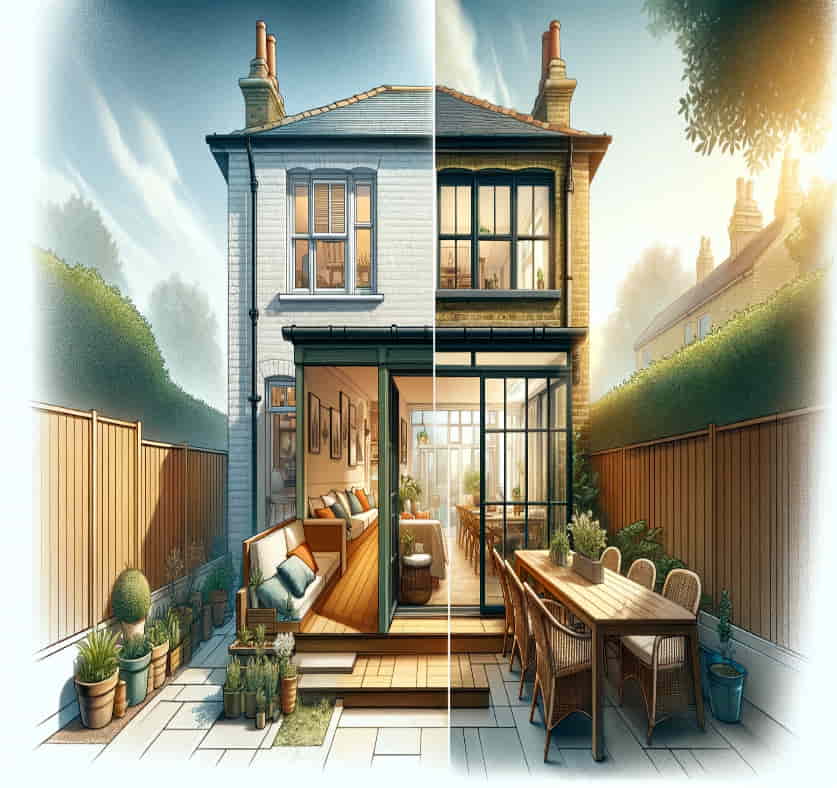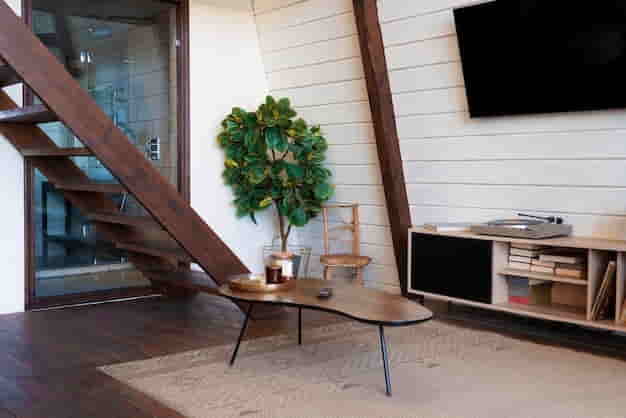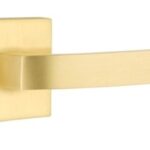Category Archives: Home Improvement
Space-Saving Solutions: Why Side Return Extensions Are Ideal for Urban Homes

Living in an urban area comes with many benefits, such as access to amenities and public transport. However, it also means limited space, especially in older homes built decades ago when families were smaller. As housing costs continue rising in cities like London, families are looking for ways to maximize their existing space rather than move farther out. One excellent solution is adding a side return extension.
What is a Side Return Extension?
A side return refers to the space between a house and the boundary line on one side. It is a small area next to the main building. A side return extension builds out from the house into this narrow area to create a new room.
Side returns are common in Victorian terraced houses and other urban homes built in the late 1800s or early 1900s. Many have 10-15 feet or 3-5 metres of unused land on one side. Adding an extension into this unused area can add valuable living space without the high costs of a full-scale renovation or move.
Benefits of Side Return Extensions
There are many excellent reasons side return extensions are an ideal space-saving solution for urban families in the UK:
1. Add Extra Room
The most obvious benefit is gaining an extra room, which can serve many functions. Popular options are expanding the kitchen, adding a downstairs bathroom, creating a playroom for kids, or building an additional bedroom. Even a modest 8 feet x 10 feet or 3 metres x 2 metres extension can make a noticeable difference. The expanded footprint provides a more usable interior floor area.
2. Increase Property Value
Adding living space naturally boosts a home’s resale value in the UK housing market. Recent data shows the average cost of side return extension in London is between £25,000 to £50,000, but adds £90,000 to £140,000 to the property value. That’s a significant return on investment for homeowners.
3. Bring in More Natural Light
Many older urban homes suffer from limited natural light, especially in the middle rooms. A side return extension can change this by creating wider windows or adding more windows along the new exterior wall. More daylight makes rooms feel more open and inviting.
4. Enhance Layout and Flow
The fixed layouts of many aging urban homes aren’t ideal for modern families. A strategic extension creates opportunities to improve how rooms connect to each other. For example, moving the kitchen into a side extension may open space for a ground-floor bathroom or larger open-plan family room.
5. Use Dead Space
A narrow side return strip often turns into wasted space. An extension allows homeowners to capitalize on this dead zone and turn it into the valuable living area. Even an extra 3 feet or 1 metre creates a usable new room.
6. Add Storage
Finally, gaining additional space in a small urban home provides more storage capacity. Built-in cabinetry and closets are easily added into a side return extension. This hidden storage helps keep clutter under control.
Design Considerations
Homeowners will want to think about the following design factors when planning a side return extension:
Size
The dimensions of the side return determine the possible size of the extension. Typical extensions range from 8 feet x 10 feet or 3 metres x 2 metres up to 15 feet x 20 feet or 5 metres x 6 metres. Smaller homes may only accommodate a one-storey extension, while larger houses can consider two storeys.
Layout
How will the layout integrate with the existing floor plan? Be sure to locate doors, hallways, and windows to maximize flow. Extending the kitchen or bathroom requires carefully mapping plumbing lines.
Foundations
Most side extensions require extra solid foundations to structurally support the new footprint. This must be dug wider and deeper than the existing foundations.
Roof
Will the extension roof attach to the main house roof, or be completely separate? Coordinate roof lines and angles.
Windows
Add ample windows along the new exterior wall for light. But avoid windows that directly overlook neighbours and cause privacy issues.
Materials
Use materials that match the existing house, such as brick, stone cladding, or siding. Consistent materials give the addition a seamless, integrated look.
Cost
As mentioned previously, side return extensions in London average £25,000 to £50,000. The specific design choices will impact the final cost.
Planning Permission for Side Extensions
Homeowners must obtain planning permission from their local council before starting work on a side return extension in the UK. There are guidelines about maximum size and height. For example, in London, the extension cannot exceed 3 metres if adjoining a house, or 4 metres for a detached or end-of-terrace house.
The planning application requires drawings of the proposed design. Be sure to have clear communication with local planning officers. Most side extensions that fit within guidelines can be approved if designed appropriately.
Finding the Right Builder
Choosing the builder is one of the most important decisions for a successful side return extension project. Look for these traits when evaluating builders:
Experience: Seek examples of previous side extensions and talk to past clients. Look for expertise specifically with urban homes.
Quality: The builder should have a reputation for high-quality work and use of good materials. Quick and cheap construction often results in problems down the road.
Communication: A builder who listens to your needs and keeps you informed throughout the process makes the experience smoother.
Fair pricing: Get quotes from a few recommended builders and compare. Be wary of prices that seem too good to be true.
Timeliness: Make sure they can dedicate adequate project management and workers to complete the extension in a reasonable timeline.
Proper certification: They must have all required building permits and certifications.
Take time to carefully research and choose the right builder for your side return extension. This improves the likelihood of an end result you are satisfied with.
Conclusion
For families needing more usable space in their urban homes, a side return extension offers a convenient and cost-effective solution. Homeowners gain valuable living area by utilizing the unused side return area adjacent to their home. A well-designed extension seamlessly blends with the existing layout. It brings benefits like more natural light, enhanced interior flow, added storage, and increased property value – all without the high cost of moving. With proper planning permission and an experienced builder, a side return extension can help maximize your enjoyment of city living.
How to Estimate and Plan Your Loft Conversion Costs

As the need for more space grows, homeowners in the United Kingdom are increasingly turning to loft conversions as a viable solution. A well-executed loft conversion not only adds functional space to your home but can also significantly increase its value. However, the path to a successful loft conversion is paved with careful planning and a thorough understanding of the associated costs. In this guide, we will walk you through the essential steps to estimate and plan your loft conversion costs, with a particular focus on the unique considerations in London.
1. Understanding the Basics of Loft Conversion Costs
Before delving into the intricacies of estimating costs in the vibrant city of London, it’s crucial to grasp the fundamental elements that contribute to loft conversion expenses. These typically include design and planning fees, structural alterations, materials, labor, and finishing touches. According to a study by the Royal Institution of Chartered Surveyors (RICS), the average cost for loft conversion in the UK is around £30,000 to £50,000, with variations based on location, size, and specifications.
2. Location Matters: Cost for Loft Conversion in London
London, with its dynamic property market and unique architectural landscape, presents its own set of challenges and opportunities when it comes to loft conversions. The cost for loft conversion in London tends to be higher than the national average due to factors such as increased demand, limited space, and stricter building regulations. According to a report by the National Building Specification (NBS), the average cost for a basic loft conversion in London ranges from £40,000 to £60,000. However, bespoke or high-end projects can surpass £100,000.
3. Factors Influencing London Loft Conversion Costs
a. Planning Permission and Building Regulations:
The first step in any loft conversion project is obtaining the necessary permissions. In London, where heritage and conservation areas abound, securing planning permission can be a complex and time-consuming process. Additionally, complying with stringent building regulations is imperative. The cost for loft conversion in London may include fees for planning applications and building control inspections.
b. Architectural Design:
Collaborating with an architect is essential for a successful loft conversion. Their expertise in maximizing space while adhering to regulations can influence the overall cost. Architectural fees in London may range from 5% to 15% of the total project cost.
4. Navigating Material Costs in the Capital
The cost of materials constitutes a significant portion of the overall budget for a loft conversion. In London, where construction costs are generally higher than in other parts of the UK, homeowners need to carefully consider the selection of materials. While quality should not be compromised, exploring cost-effective options without compromising safety and durability is essential. Consulting with a structural engineer can provide insights into suitable materials that meet both aesthetic and budgetary requirements.
5. Labour Costs: Skilled Craftsmanship Comes at a Price
The skilled labor required for a loft conversion project is a critical component of the overall cost. In London, where experienced and reputable builders may charge premium rates, it’s crucial to obtain multiple quotes and thoroughly vet potential contractors. Keep in mind that cutting corners on labor costs can result in subpar workmanship and additional expenses down the line. According to a survey by the Federation of Master Builders (FMB), the average daily rate for a tradesperson in London is significantly higher than the national average.
6. Hidden Costs: Contingency Planning for Unforeseen Expenses
No matter how meticulously you plan, unforeseen circumstances can arise during a loft conversion project. It’s advisable to allocate a contingency fund of at least 10% to 15% of the total budget to cover unexpected expenses. This can include structural issues, plumbing or electrical challenges, or modifications required to meet changing specifications. Being prepared for the unexpected is a key element in ensuring the smooth progression of your loft conversion.
Conclusion: A Worthwhile Investment in Your Home
Estimating and planning your loft conversion costs in London requires a strategic approach and careful consideration of the unique factors influencing the market. By understanding the basics, navigating through location-specific challenges, and accounting for various cost components, you can embark on a loft conversion project that not only enhances your living space but also adds significant value to your property. Remember, a well-executed loft conversion is not just an investment in your home; it’s an investment in your lifestyle and the future value of your property.
What You Need to Know About Septic Tank Cleaning?
Why Should I Clean My Septic Tank?
Septic tanks should be cleaned out every 3-5 years in order to remove any buildup of sludge or scum that has accumulated over time. If this buildup isn’t removed, it can cause issues with the functionality of your tank, including backups and clogs. Additionally, when left unchecked, these issues can lead to costly repairs or even replacements down the line.
How Do I Clean My Septic Tank?
If you’re looking to clean your septic tank yourself, there are several steps you should take in order to do it safely and effectively. First, you need to locate the access points for your tank by checking the directions given by your manufacturer when you purchased your tank. Once those have been found, make sure they are accessible by removing any vegetation or debris from around them. After that, use a pump truck or vacuum truck to empty out all the solid waste from within the tank. Finally, use an enzymatic cleaner specifically designed for septic tanks in order to break down any remaining organic material that may have been left behind after pumping out the solid waste. Be sure not to use standard household cleaners as these could damage the integrity of your tank over time.
For homeowners who don’t feel comfortable performing this work themselves, hiring a professional is always an option as well. Professional septic cleaners are experienced in dealing with all types of tanks and will be able to provide expert advice on how best to care for yours going forward. They will also be able to identify any potential problems before they become serious issues down the line.
Conclusion:
Septic tank cleaning in Alvin TX is an essential part of keeping your home running smoothly and efficiently. Whether you choose to clean it yourself or hire a professional cleaner is up to you; either way, making sure that your septic system stays healthy is key in preventing costly repairs or replacements down the line! With regular maintenance and appropriate cleaning methods, you can be sure that your septic system will remain in great shape for years come!
Difference Between Pre-Finished and Unfinished Hardwood Flooring

Pre-finished flooring is a good option if you want long-lasting finishes. But unfinished floors give you more scope of working with decors and finishes as well as colors.
Let us find out how pre-finished flooring differs from unfinished hardwood flooring.
Pre-finished Hardwood Flooring Advantages
The industrial finish that almost all pre-finished hardwood flooring has is unbeatable in terms of durability. One of the toughest finishes available is aluminum-oxide, which is applied after numerous layers of baked-on polyurethane. Some of the pre-finished hardwood flooring benefits include:
• Longer-lasting/more Resistant to Scratches
Hardwood that has been pre-finished is 7–10 times more scratch-resistant than unfinished wood. It is due to the fact that when it gets completed on-site, it often receives 2-3 coatings of polyurethane. However, when it gets manufactured in the factory, it typically receives at least 6-7 coatings that are oven baked alongside aluminum oxide, the second-hardest material in the world.
• More Orderly
Anybody who has experienced polishing and refinishing will understand what we’re talking about. With all the debris, it’s a nightmare. Did we also neglect to address the odor? By the way, a dustless method that costs a little more but significantly reduces mess should be provided to you in order to battle the dust.
• A Fast Process
Of course, the space must get considered, but the majority of pre-finished works can often get completed in 1-2 days. You cannot walk in the region at all while it is being done, which typically takes 4-5 days plus drying time. You may start using pre-finished hardwood right away.
Get absolutely stunning floor finishes from experts. You can search for them online with “hardwood flooring AZ”.
Unfinished Hardwood Flooring Advantages
No matter what kind of finishing you select to use, you will need to sand unfinished flooring first. To smooth the floor and reduce the raised edges, sanding is required.
Unfinished hardwood flooring has a number of benefits, including the following:
• Clean Edges
The edges of the majority of pre-finished hardwood have a small bevel. Some clients appreciate this because they believe it appears more authentic, but other clients appreciate the smoothed-out appearance when the floors get sanded.
• Choosing And Evaluating a Certain Color
Contrary to prefinished wood, you have the opportunity to mix and match or combine stains and polishes. However, the color options are occasionally a little more limited.
• Matching the Color of the Current Hardwood
Utilizing unfinished hardwood will be the simplest method to match it if you have hardwood in other areas of the house. Search for the right wooden flooring service provider online through search terms such as “hardwood flooring AZ”. You will be able to talk to experts and can find suitable flooring for your house.
Although pre-finished and unfinished hardwood flooring differs a lot from each other in many aspects, there certainly are some instances where one of them outshines the other.
How Gutter Guards Can Save Your Home and Your Health

The health and safety of our family are of paramount importance, and we take various measures to ensure such safety. Regular cleaning and maintenance of various installations in and around the house are a part of such efforts. However, several factors can compromise the hygiene of your living space. Also, it can jeopardize your health and safety.
Gutters are responsible for channeling the water from your roof away from your house. However, the gutters can get clogged and overflow. The leaking water can cause significant damage to the health and safety of your family members.
Gutter guards help in preventing gutter clogging and ensure safety and hygiene around your house. Let us discuss how gutter guards save your home and your health.
1. It keeps pests away from your house.
Pests and insects are always looking for safe and comfortable spaces in your house. Clogged gutters filled with debris and standing waters offer the ideal dwelling and breeding environment for pests, insects, rodents, bats, mosquitoes, etc.
Needless to mention, these pests also bring numerous diseases that can spread easily and put your family at risk. Also, cleaning the gutters after such an infestation can become a daunting task. You may need to call for professionals for gutter cleaning, which can cause additional expenses.
Gutter guards, Raleigh NC, prevent leaves twigs, and debris from getting inside your gutters and ensures the unrestricted flow of water. Hence, it prevents pest infestation and the resulting infections.
2. It reduces the risk of accidents.
It is common for people to clean their gutters just like any other installation in their house. Gutter cleaning is essential to prevent the gutters from leaking water. However, getting your ladder and climbing the roof to clean the frequently clogged gutters is quite a task.
There is always a risk of slipping and falling. A lot of people suffer from severe injuries and end up getting hospitalized for days. Also, some may lose their lives in a tragic fall.
Installing gutter guards, in Raleigh, NC, ensures that your gutters don’t get clogged frequently. Even if some debris finds its way inside the gutter, it won’t require much time to clean.
3. It prevents your property from water damage.
A gutter guard protects your house from water leakage and flooding. When the gutters get clogged, it restricts the flow of water through the gutter to the downspout. The water may start overflowing and even leak into your house.
Such a situation can be extremely inconvenient and also damage the property. Spilling on the side can also get to the other areas of your house.
Water pooling on the roof can reach the fascia boards damaging them and destructing the structural integrity of your house. Also, in case of a heavy downpour, the water can get to the basement and destroy the foundation of the building.
4. It can eliminate mold and mildew growth.
We all know that Mold and mildew growth can put your family at high risk. It can cause infections and respiratory issues. When leaves, twigs, branches, etc. get inside your gutters, they can become the most favorable ground for mold growth.
Also, stagnant water acts as a catalyst in the process. The outgrowth can spread to other parts of your house. This can be detrimental to the health of your family members, especially if you have patients suffering from asthma, allergy, and other respiratory conditions.
Also, water spillage and leaking water can cause rotting of the housing material and mold growth on its surface. Hence, to ensure that the members of your family remain free of respiratory issues, you need to install gutter guards as a preventive measure.
If you can already witness mold and mildew growth, you should call a professional to remove mold and install gutter guards to prevent such situations in the future.
These are some of the ways in which gutter guards Raleigh NC, can save your home and your health.







